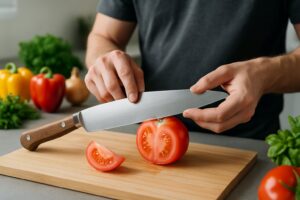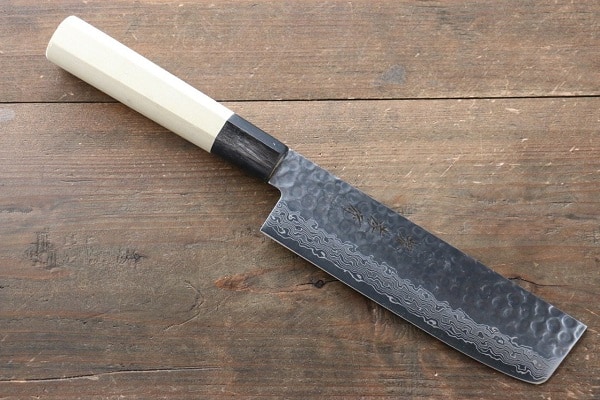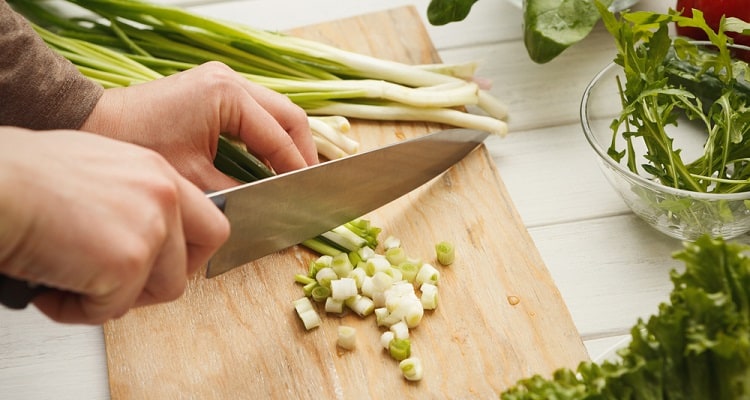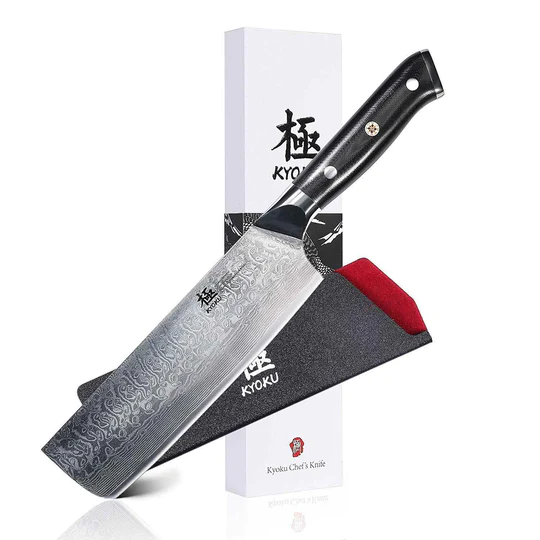


Many professional chefs prefer Japanese Knives, and the reason for the intense interest is because they are reliable kitchen tools. If you have a Japanese-style knife like the Nakiri or Bunka knife in your kitchen, you have a reliable blade to seamlessly get through your kitchen tasks.
Choosing either of the two can be a difficult choice due to their similarities. Thankfully, this article will compare Nakiri vs Bunka Knives and provide you all the information you need to make the right choice.

As we hinted earlier, the Nakiri Knife is a traditional Japanese kitchen knife. The translation of its name makes its primary function quite obvious: while ‘na’ means leaf, ‘kiri’ is cut. Essentially, it is perfect for cutting vegetables. If you’re a lover of veggies, salads, and soups, you should fancy a Nakiri knife.
The Nakiri knife typically measures between 5 and 7 inches. It boasts a perfect shape for the chopping motion thanks to the ample room it allows for your knuckles so that you do not smash them. Also, this knife features a straight blade as well as a flat front without a tip. The thin, ultra-hard, and sharp blade doesn’t require much effort to get the job done.
Besides, the Nakiri is typically a double-bevel knife (both sides are sharpened), meaning both sides of the tool are sharpened. This means your left-handed partner and right-handed child can use the knife easily. Ultimately, the Nakiri is a tremendous all-around knife but comes short when working around bones or heavy-duty cutting.

Like the Nakiri, ehe Bunka Knife is a Japanese-style knife. It is often referred to as Bunka Bocho, both Japanese words. While Bunka means ‘culture’ in English, Bocho means ‘kitchen knife’. Essentially, the Bunka Bocho is a ‘cultural kitchen knife’ which derives its name from its traditional function of helping to prepare cultural cuisine in Japan.
Some even add ‘Banno’ – which means multipurpose or convenient – to the Bunka Bocho, highlighting the knife’s versatility and convenience in use. This multipurpose knife is primarily designed for slicing, dicing, and mincing foods such as fish, vegetables, meat, and herbs. It typically measures around 5 to 7 inches like the Nakiri.
Also, the Bunka knife features a wide blade and a straight cutting edge with a pointed tip that makes it ideal for doing intricate precision work like scoring vegetables or brunoise cuts. The tip also helps to get under the sinew and fat of the meat when doing light butchering work.
The ‘reverse-tanto’ angled tip is also referred to as the ‘k-tip’ point. Aesthetically, the Bunka knife is every chef’s dream, thanks to the captivating and cool look. Like the Nakiri, the blade of the Bunka is typically double beveled, making it an excellent tool for every member of your family.
| Feature | Nakiri Knife | Bunka Knife |
| Length | 5-7 inches | 5-7 inches |
| Weight | Lightweight | Lightweight |
| Edge | Straight | Straight |
| Construction | Hand-forged or Stamped | Hand-forged |
| Blade Material | Japanese stainless steel | High-carbon steel or Damascus steel |
| Bevel | Double | Double |
After comparing the main features of the Nakiri and Bunka knives, we will discuss the standout features of the two kitchen tools below:
As we mentioned before, the Bunka knife features a pointed tip that makes it excel at intricate precision works. If you want brunoise cuts or you want to score vegetables, the Bunka knife is a great tool for you. The knife’s flat profile makes it well suited for push-cutting or tap-chopping techniques. It will easily chop your carrots for Carrot & Apple Salad. A Nakiri, due to its flat front and absence of a tip, won’t deliver satisfying precision works.
If you’ll be dicing vegetables, the Bunka knife is a smarter choice than the Nakiri knife. Although dicing is similar to chopping, which you can quickly get from the Nakiri, it is more exact than chopping. The Bunka is primarily designed for dicing vegetables, potatoes, and so on. It helps to cut the food along vertical and horizontal lines, resulting in neat dice.
Mincing is another kitchen task you can entrust the Bunka knife with. It helps mince foods into smaller bits for seasoning salads, soups, sauces, and other dishes. With its double bevel blade, you can use either side to chop foods in a back and forth motion. The pointed tip also gives the Bunka knife the precision needed to get the smaller cuts. The Nakiri knife doesn’t perform as well as Bunka in this area.
The Nakiri knife is designed to cut and chop vegetables. Apart from the literal meaning of the knife, its blade also supports that function. The Nakiri a reliable kitchen tool to easily chop vegetables such as tomatoes, cucumbers, and carrots without any stress. Although the Bunka knife also offers this function, it doesn’t do it as well as the Nakiri.
Japanese kitchen knives are very popular choices for amateur and professional chefs due to their reliable construction and excellent sharpness. The Nakiri and Bunka are great examples of Japanese-style knives, thanks to their impressive features.
While both are general-purpose chef’s knives, they offer some different functions. In some cases, one performs a function better than the other, making it difficult to choose between the two.
Luckily for you, our Nakiri vs Bunka match contains every vital information you need to make the right choice for your kitchen works.

Knife Buzz offers independent product reviews on a wide range of knives used in the kitchen, home, and outdoors. We make it easy for you to find the right knife at the best price.